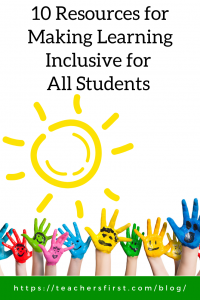 December 2 is National Special Education Day. This event celebrates the December 2, 1975 signing of the Individuals with Disabilities Education Act (IDEA) by Gerald Ford. IDEA is the basis for Special Education law in the United States and serves as the foundation for giving all children with disabilities a free and appropriate public education.
December 2 is National Special Education Day. This event celebrates the December 2, 1975 signing of the Individuals with Disabilities Education Act (IDEA) by Gerald Ford. IDEA is the basis for Special Education law in the United States and serves as the foundation for giving all children with disabilities a free and appropriate public education.
Technology offers many opportunities for providing accessibility to all students in a variety of ways. Some resources provide materials on a variety of levels, others take the content and make it more accessible by reading it aloud or changing the look for more comfortable viewing, and others allow you to modify existing content to enable learners to work at their own pace or skill level.
Thoughtful integration of online resources and technology allows educators to differentiate learning for all students but specifically helps us to adjust to the needs of learners with special needs. Here are some of my favorite, easy to use, resources for use in every classroom to make learning inclusive for all.
- Rewordify (TeachersFirst review) – Rewordify takes complex passages of texts and simplifies them to improve comprehension. Also, after streamlining the text, click on highlighted passages to get definitions and hear pronunciations of vocabulary words. Other useful features of Rewordify include options for adjusting the vocabulary levels used for documents and the creation of vocabulary lists and quizzes.
- Immersive Reader (TeachersFirst review) – Immersive Reader from Microsoft is a reading aid embedded into many Microsoft and Microsoft-affiliated products. Use this tool to have text read out loud using a variety of options, including voice speed, male or female voice, and choice of language. Other options include the ability to adjust text size and font and include a picture dictionary for visual learning. My favorite part of Immersive Reader is the Grammar Options section. Use the grammar options to break words into syllables and color code different parts of speech. In addition to Microsoft tools, Immersive Reader is available within Wakelet and Flipgrid.
- Safe YouTube (TeachersFirst review) – YouTube is an excellent resource for finding and sharing educational materials; however, many videos come with annoying advertisements. The ads aren’t only irritating; they are also distracting for many students. Paste the URL of any YouTube video into Safe YouTube to generate a link to a clutter-free version of the video. Safe YouTube may even be available to use in schools where YouTube is blocked. Just check with your IT folks to discuss the proxy filtering settings.
- BeeLine Reader (TeachersFirst review) – BeeLine Reader makes on-screen reading easier by the use of different color gradients. These color gradients allow the reader’s eyes to focus and move through content with increased speed and comprehension. Try it out at Reading is Fundamental Literacy Central, then follow the directions to add BeeLine Reader as an extension for your Chrome browser, PDF viewer, or as an app.
- Summarize This (TeachesFirst review) – Paste any text into Summarize This to view a summary of the content. Although the site doesn’t provide options to adjust the length, it is simple to use and provides opportunities for a variety of classroom uses. Use Summarize This to introduce complex text that offers students a framework before beginning to read. Have students use this tool with their writing to obtain a summary as a way to analyze their work. Use with special needs students to make difficult content more accessible.
TeachersFirst shares many more resources in our archived recordings of OK2Ask professional development sessions and Twitter Chats. Take advantage of these recordings to learn more about specific strategies and how to integrate online tools into any curriculum through these sessions guided by our edtech coaches.
- Feb 2018 OK2Ask: Free Microsoft Tools to Make Learning Accessible and Inclusive
- January 2018 OK2Ask: My Students Need That! Chrome Features & Extensions for Accessibility
- April 2019 Twitter Chat: Tech Tools for Accessibility
- July 2019 Ok2Ask: Microsoft in Education Day – Learning Tools to Build an Inclusive Classroom
- July 2019 OK2Ask: Microsoft in Education Day – 2 Free Apps for Inclusive Learning – Office Lens and Translate
Online tools offer many opportunities to support and reach the needs of all learners. Have you found some tools that are helpful in your classroom? Share tips and resources in the comments as we learn together how to make learning inclusive for all students.

